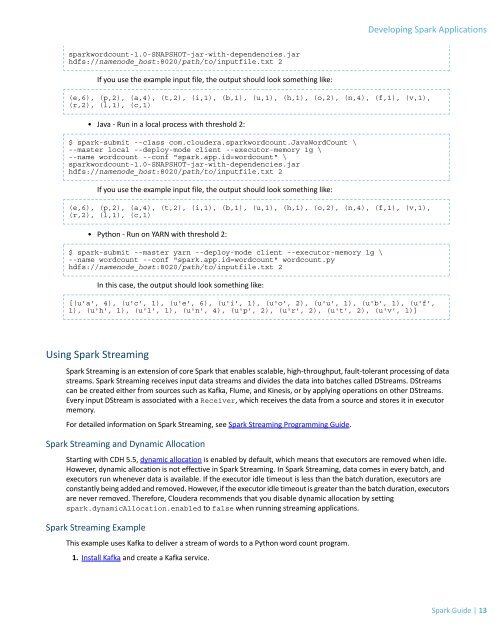cloudera-spark
Create successful ePaper yourself
Turn your PDF publications into a flip-book with our unique Google optimized e-Paper software.
Developing Spark Applications<br />
<strong>spark</strong>wordcount-1.0-SNAPSHOT-jar-with-dependencies.jar<br />
hdfs://namenode_host:8020/path/to/inputfile.txt 2<br />
If you use the example input file, the output should look something like:<br />
(e,6), (p,2), (a,4), (t,2), (i,1), (b,1), (u,1), (h,1), (o,2), (n,4), (f,1), (v,1),<br />
(r,2), (l,1), (c,1)<br />
• Java - Run in a local process with threshold 2:<br />
$ <strong>spark</strong>-submit --class com.<strong>cloudera</strong>.<strong>spark</strong>wordcount.JavaWordCount \<br />
--master local --deploy-mode client --executor-memory 1g \<br />
--name wordcount --conf "<strong>spark</strong>.app.id=wordcount" \<br />
<strong>spark</strong>wordcount-1.0-SNAPSHOT-jar-with-dependencies.jar<br />
hdfs://namenode_host:8020/path/to/inputfile.txt 2<br />
If you use the example input file, the output should look something like:<br />
(e,6), (p,2), (a,4), (t,2), (i,1), (b,1), (u,1), (h,1), (o,2), (n,4), (f,1), (v,1),<br />
(r,2), (l,1), (c,1)<br />
• Python - Run on YARN with threshold 2:<br />
$ <strong>spark</strong>-submit --master yarn --deploy-mode client --executor-memory 1g \<br />
--name wordcount --conf "<strong>spark</strong>.app.id=wordcount" wordcount.py<br />
hdfs://namenode_host:8020/path/to/inputfile.txt 2<br />
In this case, the output should look something like:<br />
[(u'a', 4), (u'c', 1), (u'e', 6), (u'i', 1), (u'o', 2), (u'u', 1), (u'b', 1), (u'f',<br />
1), (u'h', 1), (u'l', 1), (u'n', 4), (u'p', 2), (u'r', 2), (u't', 2), (u'v', 1)]<br />
Using Spark Streaming<br />
Spark Streaming is an extension of core Spark that enables scalable, high-throughput, fault-tolerant processing of data<br />
streams. Spark Streaming receives input data streams and divides the data into batches called DStreams. DStreams<br />
can be created either from sources such as Kafka, Flume, and Kinesis, or by applying operations on other DStreams.<br />
Every input DStream is associated with a Receiver, which receives the data from a source and stores it in executor<br />
memory.<br />
For detailed information on Spark Streaming, see Spark Streaming Programming Guide.<br />
Spark Streaming and Dynamic Allocation<br />
Starting with CDH 5.5, dynamic allocation is enabled by default, which means that executors are removed when idle.<br />
However, dynamic allocation is not effective in Spark Streaming. In Spark Streaming, data comes in every batch, and<br />
executors run whenever data is available. If the executor idle timeout is less than the batch duration, executors are<br />
constantly being added and removed. However, if the executor idle timeout is greater than the batch duration, executors<br />
are never removed. Therefore, Cloudera recommends that you disable dynamic allocation by setting<br />
<strong>spark</strong>.dynamicAllocation.enabled to false when running streaming applications.<br />
Spark Streaming Example<br />
This example uses Kafka to deliver a stream of words to a Python word count program.<br />
1. Install Kafka and create a Kafka service.<br />
Spark Guide | 13




